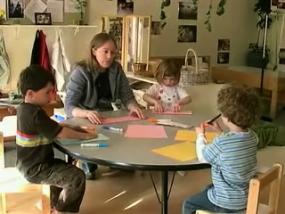Making Paper Airplanes

Luke, Sally, and Jack are learning from their teacher, Michelle, about how to make paper airplanes. To create an airplane, the children must carry out a sequence of folds using a single sheet of paper. Notice what strategies the teacher uses within the context of group instruction to help the children learn the paper airplane folding technique. She accompanies the verbal directions that she offers to the children with a demonstration. For example the teacher begins by saying, “We’re gonna make a long, skinny plane, so we’re gonna start by folding it like this (folds paper lengthwise and holds it up for children to see). So the way we can do this is if you take the two corners that are far away from you (grasps corners), then you pull them close to you like this, and make them meet. Just like that, Luke, yeah. And then you can make a long, skinny plane”. For this first step in the paper airplane making process, Luke affirms the effectiveness of the teacher’s strategy by quickly forming an analogy. He folds his paper in half and says, “Like a book!” Locate the other instances in the video clip where the teacher demonstrates while giving verbal instructions and decide if she is equally effective. Notice that the children work at varied paces. Observe how the teacher supports the developmental level of each child by using different ways to scaffold their participation. For example, when Jack says, “I need help,” the teacher responds by saying, “Well, why don’t I help you with yours?” and begins to provide him hands on guidance. However, when Jack says, “I want you to make a paper airplane for me,” the teacher replies by saying, “I want you to help this time so that next time, you’ll know how to make it”. She is careful to lend Jack the support that he needs to get started while also encouraging his growth and independence. Notice that although each child is making his or her own paper airplane, the teacher works to foster a sense of group participation. For example, before she explains the second step, the teacher pauses to ask, “Do you want to do yours, Jack, and that way we’ll all be at the same place?” And again later, she pauses the group and says, “Let’s let Sally catch up with us”. Notice that throughout their interaction, the teacher offers positive reinforcement to the children. For example, when Sally completes the second fold on the “pointy part” of her airplane, the teacher says, “Good job. Nice, Sally. Perfect. Great job. You did that all by yourself” (03:17). When in the video do you think the teacher’s use of positive reinforcement is most effective? Consider what you think may be the educational value of a paper airplane making activity. When the teacher asks Luke, Jack, and Sally to decide if they want to make “the short kind of airplane or the long kind of airplane,” all three choose “the long kind”. Given that each child is working with the same size sheet of paper, speculate about what reasoning may guide the children’s decision. Observe when Jack demonstrates an understanding about the symmetrical form of the paper airplane. He says, “Look, I’m doing it”, as he completes the first triangular fold on “the pointy part” of his airplane. He then makes a prediction about the next step by saying, “We’re gonna make another one” (02:34), and he begins to make a symmetrical fold on the opposite side of his paper. Can you find any other instances in the video when you think the children show knowledge of symmetry? What do you notice the teacher doing to help the children recognize that both sides of the airplane are the same? Notice that the teacher often describes the outcome of folding the paper as variations on the shape of a triangle (i.e., “a triangle shape”, “a bigger triangle”, “this really skinny triangle”). Do you think this strategy better enables the children to engage in spatial reasoning?
Length of stand-alone master video clip: 7 minutes 14 secs
Highlight the text above and paste to a document to have your own copy.
Keywords: Fours, Children-Teacher, Teaching, Spatial Relations, Sequence, Directions, Paper
